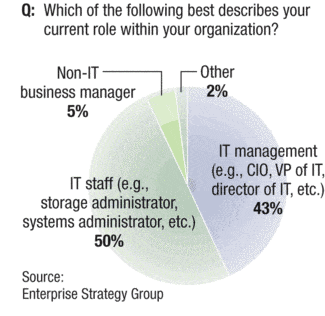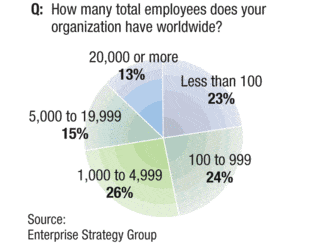It’s no secret that virtualization is one of the hottest trends in IT, but what’s less clear is how virtual servers impact end users’ storage strategies. Virtual servers have unique requirements in the areas of performance and data protection, and users are just beginning to implement storage technologies and products that will enable them to maximize the benefits of server virtualization.
This article is based on highlights from an extensive end-user survey conducted by Enterprise Strategy Group (ESG) Research, titled The Impact of Server Virtualization on Storage (primary authors: John McKnight and Mary Johnston Turner), and focuses primarily on storage infrastructure, management, data protection, and the combination of server and storage virtualization in the overall context of virtual servers.

Infrastructure options/plans
Although one of the primary benefits of server virtualization is consolidation of resources, the implementation of virtual servers often leads to significant increases in storage capacity. Over half (54%) of the virtual-server adopters have experienced a net growth in capacity, while only 7% reported a net decrease (see figure, left). ESG analysts believe those organizations reporting no change in capacity, or a decrease in capacity, may have benefited from storage consolidation or other infrastructure initiatives as part of their virtualization deployment and/or may simply be in the early stages of implementation and have not yet reached the tipping point where they experience a net increase in storage capacity. However, the overall conclusion is that server virtualization typically increases capacity requirements.

Overall, there is a clear trend toward networked storage architectures (Fibre Channel SAN, iSCSI SAN, and/or NAS), as opposed to DAS. For example, 86% of the ESG survey respondents are using networked storage, while only 14% are still relying exclusively on DAS (see figure, left).
The specific breakout (allowing for multiple responses because about half of the companies use more than one technology) today is 54% with Fibre Channel SANs, 47% with DAS, 44% with NAS, and 21% with iSCSI, although iSCSI is on the rise in virtual server environments (see figure, p. 22). For example, among users that purchased new storage systems specifically for use with virtual servers, the majority opted for iSCSI. And ESG analysts conclude that virtual servers will be a, or the, key driver behind increased adoption of iSCSI-based IP SANs.
As might be expected, Fibre Channel SANs are preferred by larger organizations, while DAS is often the preferred architecture for SMBs. Surprisingly, how-ever, adoption rates for iSCSI in virtual server environments are about the same across all sizes of organizations (as is the case for NAS).
In any case, the trend toward networked storage in virtual server environments is clear: Today, about 60% of users’ virtual server capacity is networked, and that percentage is expected to increase to 74% over the next 24 months. The most commonly cited benefits include better mobility of virtual machines across physical servers (66% of survey respondents), easier and more cost-effective disaster recovery, increased uptime and availability, more-efficient upgrades of physical servers, and high-availability storage of multiple copies of virtual machine images (54%).
(In a QuickVote poll of InfoStor readers who had deployed virtual servers, 59% said that their primary storage configuration in the virtual environment was a Fibre Channel SAN and a surprising 26% said iSCSI-based IP SANs were their primary architecture. Only 9% of our readers use NAS as their virtual-server storage infrastructure, and only 6% use DAS.)
Storage management issues
Virtual servers force users to address storage management and data-protection issues such as backup, remote replication, capacity planning, and information security in new ways. But of all the concerns about implementing virtual server environments, performance comes out on top although, collectively, storage management issues are also of great concern (see figure, p. 22).
The storage management functions that are of most interest to users, in decreasing order, are backup and restore (61% of the ESG survey respondents), snapshots, capacity planning/management, remote replication, storage virtualization, data migration, storage provisioning, local replication, data de-duplication, policy-based storage tiering, and thin provisioning (cited by 14% of the respondents).
However, according to results from the ESG survey, users are still confused about where certain storage management functions should reside (e.g., in the server virtualization software, application software, storage system, storage virtualization application, or in network devices such as switches). Generally speaking, the majority would prefer storage functionality or services to reside in the storage systems.
Data protection
In the ESG survey, 75% of the users reported that their virtualized and non-virtualized environments share the same backup processes and tools (while 20% use separate tools for the two environments, and the rest did not know). However, ESG analysts note that the clear trend may be toward implementing different backup/restore tools for the two environments; in other words, users will prefer to use backup/restore tools that are specifically designed for virtual server environments. Another observation is that users are beginning to think about backing up and restoring entire servers (e.g., virtual machine images), as opposed to concentrating on just data backup and restore.
And it’s not surprising that end users expect server virtualization and consolidation to reduce the total number of backup licenses they have to purchase. (Almost a quarter of the survey respondents report that they have been able to reduce the number of backup licenses after deploying virtual servers.) To that end, a variety of vendors are eliminating the need to have backup agents on every virtual machine. And in a related survey finding, 17% of the users have changed their backup software as a direct result of implementing server virtualization.
Disaster recovery
Improving disaster recovery is one of the driving forces behind the combination of server virtualization and networked storage. In the ESG survey, 26% of the virtual server users said they are replicating virtual machines to a remote disaster-recovery site, and another 39% plan to do so.
One of the advantages of server virtualization is that it enables users to replicate many servers to relatively inexpensive virtual machines rather than to physical servers, which significantly reduces the primary barrier to disaster recovery: high costs. In addition, disaster recovery with virtual machines can be less costly than with physical servers because the process can in many cases be managed by the virtualization software.

A primary driving force behind remote replication in the context of server virtualization is end users’ desire to reduce their recovery time objectives (RTOs). For example, 85% of the survey respondents agree that replicating virtual machine images for disaster recovery will enable their organizations to lower their RTO.
Server+storage virtualization
Although server virtualization and storage virtualization are usually viewed separately by IT organizations, the clear trend is toward a merging of the two technologies. (ESG defines storage virtualization as “software functionality that provides the ability to take multiple storage systems—including devices from different vendors and/or classes of devices from the same vendor—and treat those devices as a single, centrally managed pool of storage.)
For example, among current users of server virtualization, 24% have deployed a storage virtualization solution in conjunction with their virtual server environment. And an additional 18% plan to implement storage virtualization in the next 12 months (see figure, bottom right).

After explaining the fundamental benefits of combining server virtualization and storage virtualization, the ESG analysts wrap up this section of their report with the following: “The combined use of server and storage virtualization also makes sense from a technology perspective. The primary benefits of server virtualization in the eyes of most users include lower costs, improved resource utilization, non-disruptive upgrades and increased availability—all of which are fundamentally enabled by de-coupling servers, applications, and data from specific physical assets. Storage virtualization takes those same benefits and extends them to the underlying storage domain. Just as using networked storage for virtual machines instead of DAS means that there is no single point of failure at a disk system level that can bring down many virtual machines at once, storage virtualization adds yet- another layer of protection against failures—extending full hardware independence from the server domain to the storage domain.

ESG survey methodology
For The Impact of Server Virtualization on Storage report, ESG Research conducted an online survey of IT and business professionals in North America, Western Europe, and Asia. To qualify for the survey, respondents were required to have day-to-day responsibility for managing server technology and associated data storage infrastructure for their organization. Respondent organizations also had to be currently using, or planning to use, x86 server virtualization.


